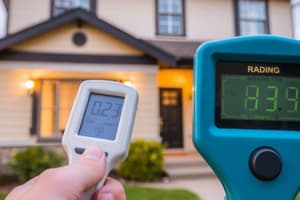Podcast
Questions and Answers
What is the primary purpose of a home inspection?
What is the primary purpose of a home inspection?
- To determine the market value of the property
- To determine the suitability of the property for a specific use
- To identify and disclose observable material defects (correct)
- To guarantee the property is free from future defects
What does a home inspection typically NOT include?
What does a home inspection typically NOT include?
- Examination of the water heater
- Examination of the electrical panel and wiring
- Radon testing (correct)
- Examination of the roof
What is a 'material defect' in the context of a home inspection?
What is a 'material defect' in the context of a home inspection?
- A potential future problem that may arise
- A specific problem that could significantly affect property value or pose a risk (correct)
- A minor cosmetic issue with no impact on value or safety
- Any issue that the homeowner is already aware of
Who typically benefits from a home inspection?
Who typically benefits from a home inspection?
Which of these locations is a home inspector likely to examine?
Which of these locations is a home inspector likely to examine?
What is the main difference between a home inspection and an appraisal?
What is the main difference between a home inspection and an appraisal?
What should a buyer do after receiving a home inspection report?
What should a buyer do after receiving a home inspection report?
Which of the following is a common issue found during home inspections?
Which of the following is a common issue found during home inspections?
What does a home inspection report typically include?
What does a home inspection report typically include?
Why is it important to verify a home inspector's credentials?
Why is it important to verify a home inspector's credentials?
What is the purpose of inspecting gutters and downspouts?
What is the purpose of inspecting gutters and downspouts?
What is examined during the 'electrical' portion of a home inspection?
What is examined during the 'electrical' portion of a home inspection?
What is the purpose of a 'new construction' home inspection?
What is the purpose of a 'new construction' home inspection?
What should homeowners do after the home inspection?
What should homeowners do after the home inspection?
Which of the following is NOT a limitation of a home inspection?
Which of the following is NOT a limitation of a home inspection?
What does 'HVAC' stand for in the context of a home inspection?
What does 'HVAC' stand for in the context of a home inspection?
What are 'standards of practice' for home inspectors?
What are 'standards of practice' for home inspectors?
What plumbing components are typically inspected?
What plumbing components are typically inspected?
What is the purpose of examining the grading of the property?
What is the purpose of examining the grading of the property?
What might a buyer do if a home inspection reveals significant defects?
What might a buyer do if a home inspection reveals significant defects?
Flashcards
Home Inspection
Home Inspection
A non-invasive, visual examination of a residential dwelling for a fee, adhering to industry standards.
Material Defect
Material Defect
A specific problem with a system or component that significantly impacts the property's value or poses a risk.
Exterior Home Inspection
Exterior Home Inspection
Exterior walls, roof, gutters, walkways, patios, decks, grading, and foundation.
Interior Home Inspection
Interior Home Inspection
Signup and view all the flashcards
HVAC Home Inspection
HVAC Home Inspection
Signup and view all the flashcards
Plumbing Home Inspection
Plumbing Home Inspection
Signup and view all the flashcards
Electrical Home Inspection
Electrical Home Inspection
Signup and view all the flashcards
Home Inspection Standards
Home Inspection Standards
Signup and view all the flashcards
Home Inspection Report
Home Inspection Report
Signup and view all the flashcards
Benefits of a Home Inspection
Benefits of a Home Inspection
Signup and view all the flashcards
Common Home Inspection Issues
Common Home Inspection Issues
Signup and view all the flashcards
Inspection vs. Appraisal
Inspection vs. Appraisal
Signup and view all the flashcards
New Construction Inspections
New Construction Inspections
Signup and view all the flashcards
Home Maintenance
Home Maintenance
Signup and view all the flashcards
Purpose of a Home Inspection
Purpose of a Home Inspection
Signup and view all the flashcards
Scope of a Home Inspection
Scope of a Home Inspection
Signup and view all the flashcards
Standards of Practice
Standards of Practice
Signup and view all the flashcards
Inspectors vs. Appraisers
Inspectors vs. Appraisers
Signup and view all the flashcards
Choosing a Home Inspector
Choosing a Home Inspector
Signup and view all the flashcards
After Inspection
After Inspection
Signup and view all the flashcards
Study Notes
- A home inspection is a non-invasive, visual examination of a residential dwelling
- It is performed for a fee, and adheres to accepted industry standards
- Home inspections are typically conducted when a home is being sold
- The purpose of a home inspection is to identify and disclose observable material defects within a house
- A material defect is a specific problem with a system or component of a residential property
- It may have a significant, adverse impact on the value of the property
- It may pose an unreasonable risk to people
- The scope of a home inspection is limited to the readily accessible and visually observable components of a home
Key Components of a Home Inspection:
- Exterior:
- The inspector examines the exterior walls, including siding, trim, and flashing
- The inspector examines the roof covering, vents, flashings, and trim
- The inspector examines the gutters and downspouts for proper drainage
- The inspector examines the walkways, patios, and decks
- The inspector examines the grading of the property and the foundation
- Interior:
- The inspector examines the interior walls, ceilings, and floors
- The inspector examines the windows and doors
- The inspector examines the stairways and railings
- The inspector examines the kitchen and bathrooms, including the plumbing fixtures
- The inspector examines the basement or crawl space for moisture, structural issues, and proper ventilation
- Heating, Ventilation, and Air Conditioning (HVAC):
- The inspector examines the heating system, including the furnace, heat pump, or boiler
- The inspector examines the cooling system, including the air conditioner or heat pump
- The inspector examines the ductwork and ventilation systems
- The inspector examines the thermostat
- Plumbing:
- The inspector examines the water supply system, including the pipes, faucets, and fixtures
- The inspector examines the drain, waste, and vent system
- The inspector examines the water heater
- The inspector examines the sump pump (if present)
- Electrical:
- The inspector examines the electrical panel and wiring
- The inspector examines the outlets and switches
- The inspector examines the lighting fixtures
- The inspector examines the grounding system
Limitations of a Home Inspection:
- Home inspections are not technically exhaustive
- Home inspections do not identify concealed or latent defects
- Home inspections do not determine the market value of the property
- Home inspections do not determine the suitability of the property for a specific use
- Home inspections do not guarantee that the property is free from defects in the future
- Home inspections do not include specialized testing or inspections, such as radon testing, mold testing, or asbestos testing
Standards of Practice:
- Home inspectors typically follow established standards of practice
- These standards define the scope of the inspection
- These standards outline the procedures for conducting the inspection
- These standards specify the content of the inspection report
- Common standards are from organizations such as ASHI (American Society of Home Inspectors) and InterNACHI (International Association of Certified Home Inspectors)
The Inspection Report:
- The home inspector provides a written report to the client
- The report summarizes the findings of the inspection
- The report identifies any material defects observed
- The report provides recommendations for repair or further evaluation
- The report typically includes photographs to illustrate the findings
- The report is not a guarantee or warranty
Benefits of a Home Inspection:
- It provides buyers with valuable information about the condition of the property
- It helps buyers make informed decisions about purchasing the property
- It may help buyers negotiate a lower purchase price or request repairs from the seller
- It gives sellers an opportunity to identify and address any issues before listing the property
- It reduces the risk of unexpected expenses for both buyers and sellers
Choosing a Home Inspector:
- Look for a qualified and experienced home inspector
- Verify the inspector's credentials and certifications
- Check for membership in professional organizations
- Read online reviews and ask for referrals
- Confirm that the inspector carries adequate insurance
- Review the inspector's sample report
- Ask about the inspector's experience with similar properties
Common Issues Found During Home Inspections:
- Roof damage (leaks, missing shingles, improper flashing)
- Foundation cracks or settling
- Water damage (leaks, moisture intrusion, mold growth)
- Electrical problems (faulty wiring, overloaded circuits)
- Plumbing issues (leaks, corrosion, inadequate water pressure)
- HVAC system deficiencies (inefficient operation, lack of maintenance)
- Pest infestations (termites, rodents)
- Structural problems (damaged framing, sagging floors)
What Happens After the Inspection:
- The buyer reviews the inspection report with their real estate agent
- The buyer may request the seller to make repairs or provide a credit
- The buyer may renegotiate the purchase price based on the inspection findings
- The buyer may choose to proceed with the purchase, even with identified issues
- The buyer may choose to terminate the purchase agreement if the issues are too significant
- It is recommended to consult with qualified contractors or specialists for further evaluation or repairs
Home Inspection vs. Appraisal:
- A home inspection assesses the condition of the property
- An appraisal determines the market value of the property
- Inspections are typically performed for the buyer's benefit
- Appraisals are typically required by lenders for financing purposes
- While an inspector looks for defects, an appraiser compares the property to similar properties in the area
New Construction Inspections:
- Home inspections are not limited to existing homes
- New construction inspections can identify issues before they become major problems
- New construction inspections can ensure that the home was built to code
- There are typically several inspections during the construction process, but a final inspection by a qualified inspector is recommended
Maintaining Your Home After the Inspection:
- Address any issues identified in the inspection report promptly
- Perform regular maintenance to prevent future problems
- Keep gutters clean and free of debris
- Monitor for leaks and moisture intrusion
- Inspect the roof regularly for damage
- Service the HVAC system annually
- Maintain proper ventilation in the attic and crawl space
Studying That Suits You
Use AI to generate personalized quizzes and flashcards to suit your learning preferences.




